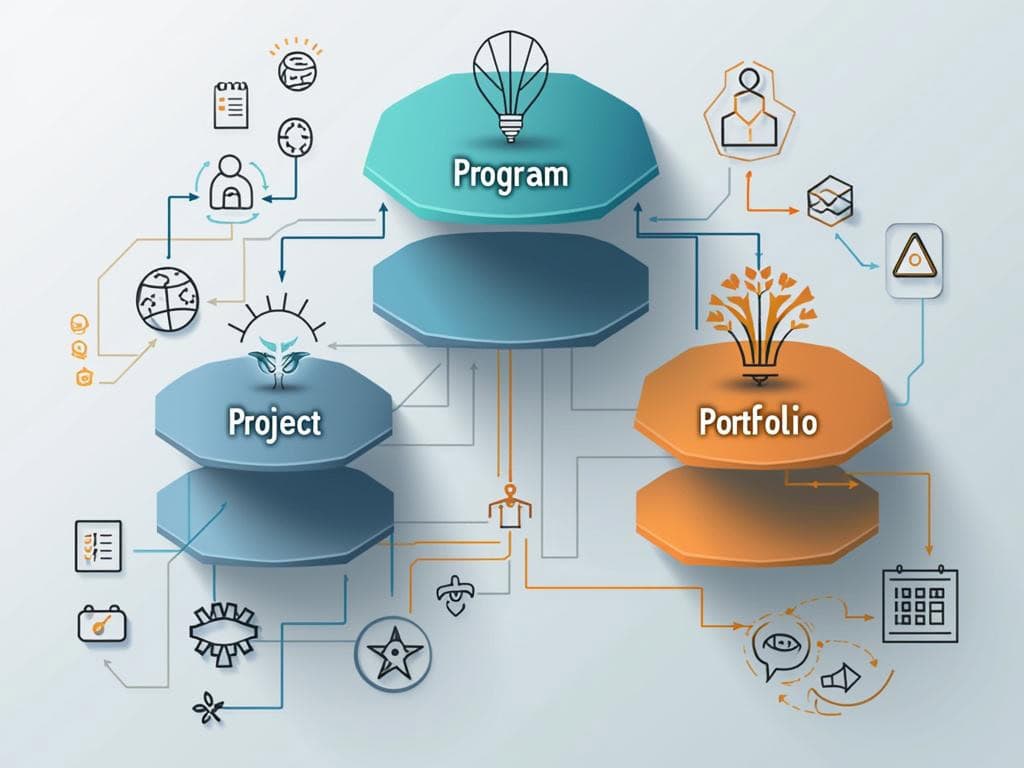
Project, Program, and Portfolio Management
Project, program, and portfolio management offers a complete, hierarchical system for organizing work that aligns with company strategy while optimizing resources effectively. This framework gives businesses a structured approach to execute tasks efficiently while maintaining focus on long-term goals through connected management disciplines.
Key Takeaways
- Project, program, and portfolio management creates a unified system for executing organizational work with increasing strategic perspectives.
- Each management level (project, program, portfolio) serves distinct but complementary functions in achieving business goals.
- The approach enables adaptive organizational capabilities that support navigation through dynamic business environments.
- Effective implementation provides improved efficiency, strategic alignment, and competitive advantage.
- The management hierarchy transforms tactical execution into strategic organizational governance.
Understanding these management approaches helps you build a comprehensive management framework for your organization. The interconnected nature of these disciplines creates a powerful system that balances day-to-day execution with long-term strategy.
Each level addresses specific needs—from detailed task completion to broad strategic oversight. This structure allows organizations to adapt quickly to market changes while maintaining consistent progress toward objectives.
Companies that master this hierarchical approach gain significant advantages in resource allocation, risk management, and digital transformation initiatives. The integration of these management practices creates organizational agility that directly impacts bottom-line results.
“Project, program, and portfolio management forge a unified framework that elevates tactical execution into strategic governance, fostering adaptive capabilities in an ever-changing business landscape. By interlinking distinct functions at each management level, organizations can optimize resources, enhance efficiency, and maintain a steadfast commitment to long-term objectives.”
Defining the Management Landscape
The hierarchical approach to organizational work management encompasses three interconnected disciplines: project, program, and portfolio management. This strategic framework provides the structure needed for achieving business objectives through proper governance, strategic alignment, and resource optimization. Project, program, and portfolio management creates a unified system that enables organizations to execute work efficiently while maintaining focus on long-term goals.
The Three-Tier Management Structure
Project, program, and portfolio management operates as a tiered system with each level serving distinct but complementary functions:
Project Management forms the foundation of execution by focusing on single, temporary endeavors with clearly defined start and end dates. You’ll find these initiatives deliver unique products, services, or results while managing:
- Day-to-day operational activities
- Resource allocation within project boundaries
- Risk mitigation at the project level
- Performance tracking against specific project KPIs
Program Management coordinates complex initiatives by managing groups of related projects with interconnected objectives. This level bridges tactical execution with strategic planning alignment, focusing on:
- Inter-project resource coordination
- Dependency management between related projects
- Strategic optimization across project groups
- Creating synergy among project teams
Portfolio Management provides strategic organizational governance through holistic management of all projects and programs. You’ll gain continuous strategic evaluation capabilities and improved resource allocation through:
- Prioritizing initiatives based on strategic value
- Maximizing return on investment
- Balancing organizational risk exposure
- Aligning work with overarching business objectives
This table illustrates the key differences between each project, program, and portfolio management level:
| Management Level | Primary Focus | Time Horizon | Key Responsibilities |
|---|---|---|---|
| Project | Tactical execution | Short-term | Deliverable creation, schedule/budget control |
| Program | Benefit realization | Medium-term | Coordination, dependency management |
| Portfolio | Strategic alignment | Long-term | Investment decisions, resource optimization |
The progression from project to portfolio management creates increasing strategic perspective at each level. This structure enables adaptive organizational capabilities that support navigation through dynamic business environments. With effective project, program, and portfolio management practices in place, you’ll achieve improved efficiency, better strategic alignment, and enhanced competitive advantage.

Project Management: The Foundation of Execution
Project management forms the cornerstone of effective project program and portfolio management frameworks in today’s organizations. As the most tactical level of work management, project management focuses on delivering specific outcomes through temporary endeavors with clearly defined parameters.
You’ll find project management drives execution through concentrated efforts on individual initiatives. Each project has distinct boundaries – a defined beginning and end, specific objectives, and dedicated resources. The discipline requires balancing scope, time, budget, and quality to produce unique products, services, or results that fulfill stakeholder requirements.
Project managers shoulder these critical responsibilities:
- Overseeing daily operational activities and task execution
- Allocating human and material resources within project constraints
- Identifying and mitigating risks that could impact project outcomes
- Tracking performance metrics against established project KPIs
- Maintaining communication with stakeholders and team members
Success in project management depends on specific measurable factors. The table below outlines the primary success metrics that determine project performance:
| Success Metric | Description | Importance in Project Program and Portfolio Management |
|---|---|---|
| On-time delivery | Completion according to schedule | Enables program milestone achievement |
| Budget adherence | Keeping costs within approved limits | Ensures portfolio financial efficiency |
| Scope fulfillment | Delivering all required features/outcomes | Supports program benefit realization |
| Quality standards | Meeting technical and performance requirements | Builds organizational credibility |
Strategic Alignment Within the Management Hierarchy
Project management doesn’t exist in isolation – it functions as the execution engine within broader project program and portfolio management structures. While project management focuses on tactical delivery, its alignment with organizational strategy creates sustainable value.
You can enhance this strategic connection by implementing project portfolio management processes that evaluate and prioritize initiatives. This ensures your projects contribute to higher-level objectives while making efficient use of limited resources.
Effective project management also requires robust governance mechanisms. By establishing clear decision-making frameworks and action logs, you’ll maintain control while enabling the flexibility needed to respond to changing conditions.
The foundation established through disciplined project management creates the stability needed for successful program coordination and portfolio optimization. Without this solid base, higher-level project program and portfolio management activities cannot effectively deliver strategic value to your organization.

Program Management: Coordinating Complex Initiatives
Program management sits at the crucial intersection between tactical project execution and strategic organizational alignment. You’ll find that effective project program and portfolio management creates a seamless flow from execution to strategy, with program management serving as the vital bridge between individual projects and overarching business goals.
Program managers coordinate groups of related projects with interconnected objectives to deliver benefits that wouldn’t be possible if these projects operated in isolation. This coordinated approach ensures your organization can tackle complex initiatives that span multiple departments, timeframes, and resource pools.
Key Focus Areas of Program Management
When implementing project program and portfolio management, your program managers must excel in several critical areas:
- Inter-project resource coordination: Allocating people, budget, and materials across multiple projects to maximize efficiency
- Dependency management: Identifying and managing connections between different projects to prevent bottlenecks
- Strategic project group optimization: Adjusting project priorities and timelines to achieve the best overall program outcomes
- Synergy creation: Fostering collaboration between project teams to develop innovative solutions
Program management enables your organization to realize comprehensive benefits beyond what individual projects can deliver. By integrating project management efforts, you’ll see improved coordination, reduced redundancy, and enhanced strategic alignment.
The relationship between projects, programs, and portfolios follows a hierarchical progression. While project managers focus on delivering specific outputs, program managers ensure these outputs collectively create meaningful outcomes aligned with organizational goals. This middle-tier position makes program management particularly challenging, requiring both detailed oversight and strategic vision.
Your program managers must balance tactical concerns with strategic objectives, serving as translators between executive leadership and project teams. This requires exceptional active listening skills and the ability to communicate effectively across organizational levels.
| Aspect | Project Management | Program Management |
|---|---|---|
| Focus | Single initiative | Multiple related projects |
| Timeframe | Defined start/end | Longer-term, often evolving |
| Success Metrics | On-time, on-budget, in-scope | Strategic benefit realization |
| Risk Management | Project-specific risks | Cross-project and program-level risks |
| Resource Control | Within project boundaries | Across multiple projects |
Successful project program and portfolio management implementation requires developing cross-functional capabilities and establishing flexible governance frameworks. By investing in the right tools and methodologies, you’ll create an environment where program managers can effectively coordinate complex initiatives while maintaining alignment with your organization’s strategic vision.
Organizations that excel in project management and program management see 28% more of their projects succeed than organizations with less mature approaches.
forbes.com
Portfolio Management: Strategic Organizational Governance
Portfolio management forms the pinnacle of project program and portfolio management hierarchy, offering a holistic approach to governing all organizational initiatives. You’ll find it provides essential strategic oversight that transforms how resources are allocated across your enterprise.
Portfolio management continuously evaluates projects and programs against strategic objectives, ensuring your organization invests in initiatives that deliver maximum value. This approach helps you balance competing demands while maintaining focus on long-term goals.
The core responsibilities of effective portfolio management include:
- Strategic alignment of all initiatives with business objectives
- Optimal resource allocation across multiple programs and projects
- Risk balancing across the entire organizational portfolio
- Investment prioritization based on strategic value and ROI
- Performance monitoring at the enterprise level
Strategic Decision Support Framework
Portfolio management serves as a critical decision support system for your executive leadership. Through strategic dashboard implementation, you’ll gain visibility into how your project investments connect to business outcomes. This framework enables you to:
- Evaluate proposals against strategic criteria
- Terminate underperforming initiatives
- Reallocate resources to high-value opportunities
- Identify redundancies across project program and portfolio management
- Forecast resource needs and capacity requirements
The right program portfolio management tools enhance your ability to visualize relationships between initiatives and make data-driven decisions. These systems consolidate information from various project program and portfolio management levels, creating a single source of truth.
| Management Level | Primary Focus | Key Metrics | Strategic Impact |
|---|---|---|---|
| Project Management | Single initiative delivery | Time, cost, scope | Tactical outcomes |
| Program Management | Related initiatives coordination | Benefits realization | Operational improvements |
| Portfolio Management | Enterprise-wide strategic alignment | ROI, strategic fit | Competitive advantage |
By implementing robust portfolio governance, you enable the four steps in the project portfolio management process to function effectively. This creates a feedback loop that continuously refines your project program and portfolio management practices, keeping them responsive to changing business conditions.

Interconnections and Organizational Impact
The hierarchical progression from project to portfolio management creates a powerful strategic framework that transforms how your organization manages work. Effective project management, program, and portfolio management provides increasingly broader perspectives as you move up the management hierarchy, enabling your business to adapt quickly to market changes.
At the foundation, project management handles specific deliverables with defined timelines, while program management coordinates related projects to achieve broader benefits. Portfolio management sits at the strategic apex, aligning all initiatives with your organizational objectives and ensuring optimal resource distribution.
This integrated approach to project, program, and portfolio management allows your organization to:
- Balance short-term tactical needs with long-term strategic goals
- Optimize resource allocation across all organizational initiatives
- Create standardized governance frameworks that improve decision-making
- Enhance visibility into dependencies between different work streams
- Develop consistent prioritization methods that reflect business priorities
Dynamic Capability Development
Implementing comprehensive project, program, and portfolio management practices helps you build essential organizational capabilities. Your teams can better navigate complex business environments when supported by structured management approaches that connect strategic vision to execution.
The following table illustrates how each management level contributes to your organizational capabilities:
| Management Level | Primary Focus | Organizational Capability Impact |
|---|---|---|
| Project Management | Tactical execution | Operational excellence and delivery reliability |
| Program Management | Benefit realization | Cross-functional coordination and synergy creation |
| Portfolio Management | Strategic alignment | Resource optimization and investment prioritization |
By establishing these interconnected layers of project, program, and portfolio management, you gain the ability to execute the portfolio management process with greater precision. This creates an adaptive organization capable of responding to market changes while maintaining strategic direction.
The real power of integrated project, program, and portfolio management comes from information flow between levels – ensuring tactical decisions support strategic goals while providing leadership with execution insights that inform future planning. When properly implemented, this approach creates a responsive management ecosystem that improves your competitive positioning through enhanced organizational agility.
Implementing Effective Management Practices
Developing Integrated Management Capabilities
You’ll gain significant organizational advantages by implementing effective project program and portfolio management practices. These integrated approaches create a structured framework that connects strategic vision with tactical execution. Project program and portfolio management serves as the backbone of successful organizational transformation, helping you navigate complex business landscapes with greater confidence.
To successfully implement project program and portfolio management within your organization, consider these essential practices:
- Establish clear governance structures that define roles, responsibilities, and decision-making authorities
- Develop standardized methodologies that can be scaled across different types of initiatives
- Create centralized resource management processes to optimize allocation
- Implement consistent reporting mechanisms that provide visibility across all levels
- Build strategic alignment processes to ensure initiatives support organizational goals
- Design benefit realization frameworks to track and maximize ROI
The proper implementation of project program and portfolio management tools provides critical support for decision-making. Program portfolio management tools should seamlessly connect project-level activities with strategic objectives, ensuring data flows effectively across all management layers.
A comprehensive approach to project program and portfolio management includes developing cross-functional capabilities within your teams. You’ll need professionals who understand both tactical execution and strategic alignment. The four steps in the project portfolio management process – identification, categorization, evaluation, and selection – provide a structured pathway for initiatives.
Effective project program and portfolio management requires flexible governance frameworks that can adapt to changing business conditions. This allows you to maintain strategic direction while accommodating tactical adjustments as needed. By implementing proper strategic project management practices, you’ll create pathways for continuous organizational improvement.
The benefits of well-implemented project program and portfolio management include enhanced operational efficiency, better resource utilization, and improved competitive positioning. Your organization will develop greater resilience through improved risk management and more effective strategic execution. Project program and portfolio management creates the foundation for sustainable growth by ensuring initiatives remain aligned with evolving organizational objectives.
Technology platforms supporting project program and portfolio management have evolved significantly, offering integrated solutions that provide visibility across all management layers. These tools facilitate collaboration, standardize processes, and generate the insights needed for informed decision-making at each management level.






